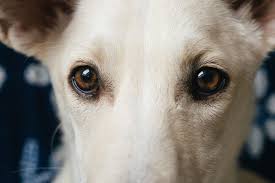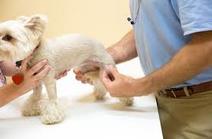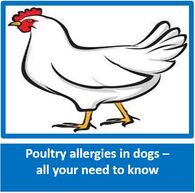|
By finding out what the breed make-up is of your small breed dog, you will gain knowledge about possible genetic pre-dispositions, breed related behaviour concerns, exercise needs, general socialization skills, as well as common health problems, and, it can satisfy your curiosity - it is amazing how often owners and shelters guess the up breed make-up incorrectly and are surprised when they get the DNA results! Totally non-invasive, easy to do, and from the comfort of your home. For more info www.muttmix.co.za
|
Mixed Small Breeds - Personality, Dog's Needs, Health Info, Genetic Predisposition
"Mini "Mutts"
www.bakerstownah.com
"Mini "Mutts"
www.bakerstownah.com
 Morkie - cross between Maltese and Yorki
Morkie - cross between Maltese and Yorki
The Small Mixed Breed, or "Mutt," is more special than that name might suggest! Though you may never know exactly what to expect, smaller dogs often have these traits:
- Well suited as a companion dog
- Compact and travels well
- Loving and loyal to her owners
- Excellent watchdog
- Alert, curious, and busy
- Difficult to housetrain
- Can be aggressive, fearful, or snappy if not socialized properly
- Has a tendency to bark quite a bit if the behavior is rewarded
- Prone to separation anxiety
- Needs regular exercise and diet regulation to avoid weight gain

No matter her small size, she has a giant heart, and she’ll love you as much as any large breed!
Dogs are one of the earliest species of domesticated animals, possibly even the first! Kept as companions for protection, hunting, and sociability, the ancestors of modern-day dogs helped establish themselves in the long term as man's true best friend. Believe it or not, every breed of dog today is derived from one early species of wolf! Yes, even Chihuahuas and Great Danes came from the same wolf ancestor! Over the thousands of years that dogs have lived with humans, they have been selectively bred for many different traits, such as size, intelligence, athleticism, and even just cuteness, eventually establishing all the breeds we know and love today. The downside to selective breeding can be a genetic predisposition to certain syndromes, illness, or injuries and your Mixed Breed is at risk for inherited conditions passed down from the dam and sire. Whether your pup is purebred or mixed, he's 100% dog at heart, and considering the history of the species, that's saying a lot!
Dogs are one of the earliest species of domesticated animals, possibly even the first! Kept as companions for protection, hunting, and sociability, the ancestors of modern-day dogs helped establish themselves in the long term as man's true best friend. Believe it or not, every breed of dog today is derived from one early species of wolf! Yes, even Chihuahuas and Great Danes came from the same wolf ancestor! Over the thousands of years that dogs have lived with humans, they have been selectively bred for many different traits, such as size, intelligence, athleticism, and even just cuteness, eventually establishing all the breeds we know and love today. The downside to selective breeding can be a genetic predisposition to certain syndromes, illness, or injuries and your Mixed Breed is at risk for inherited conditions passed down from the dam and sire. Whether your pup is purebred or mixed, he's 100% dog at heart, and considering the history of the species, that's saying a lot!
Your Mixed-Breed Dog’s Health
We know that because you care so much about your dog, you want to take good care of him. That is why we have summarized the health concerns we will be discussing with you over the life of your Small Mixed-Breed. By knowing about health concerns specific to large dogs, we can tailor a preventive health plan to watch for and hopefully prevent some predictable risks.
This guide contains general health information important to all canines as well as the most important genetic predispositions for Small Breeds. This information helps you and us together plan for your pet’s unique medical needs. At the end of the article, we have also included a description of what you can do at home to keep your pet looking and feeling his best. You will know what to watch for, and we will all feel better knowing that we’re taking the best possible care of your pal.
General Health Information for your Small Mixed-Breed
Dental Disease
Dental disease is the most common chronic problem in pets, affecting 80% of all dogs by age two. Dental disease starts with tartar build-up on the teeth and progresses to infection of the gums and roots of the teeth. If we don’t prevent or treat dental disease, your buddy may lose her teeth and be in danger of damage to her kidneys, liver, heart, and joints. In fact, your pet’s life span may even be cut short by one to three years! We’ll clean your dog’s teeth regularly and let you know what you can do at home to keep those pearly whites clean.
Infections
Small Breeds are susceptible to bacterial and viral infections — the same ones that all dogs can get — such as parvo, rabies, and distemper. Many of these infections are preventable through vaccination, which we will recommend based on her age, the diseases we see in our area, and other factors.
Obesity
Obesity can be a significant health problem in Small Breed dogs. It is a serious disease that may cause or worsen joint problems, metabolic and digestive disorders, back pain, and heart disease. Though it’s tempting to give your pal food when she looks at you with those soulful eyes, you can “love her to death” with leftover people food and doggie treats. Instead, give her a hug, brush her fur or teeth, play a game with her, or perhaps take her for a walk. She’ll feel better, and so will you!
Parasites
All kinds of worms and bugs can invade your pet’s body, inside and out. Everything from fleas and ticksto ear mites can infest her skin and ears. Hookworms, roundworms, heartworms, and whipworms can get into her system in a number of ways: drinking unclean water, walking on contaminated soil, or being bitten by an infected mosquito. Some of these parasites can be transmitted to you or a family member and are a serious concern for everyone. For your canine friend, these parasites can cause pain, discomfort, and even death, so it’s important that we test for them on a regular basis. Your Bakerstown Animal Hospital team also recommend preventive medication as necessary to keep her healthy.
Spay or Neuter
One of the best things you can do for your Small Breed is to have her spayed (neutered for males). In females, this means we surgically remove the ovaries and usually the uterus, and in males, it means we surgically remove the testicles. Spaying or neutering decreases the likelihood of certain types of cancers and eliminates the possibility of your pet becoming pregnant or fathering unwanted puppies. Performing this surgery also gives us a chance, while your pet is under anesthesia, to identify and address some of the diseases your dog is likely to develop. For example, if your pet needs hip X-rays or a puppy tooth extracted, this would be a good time—it’s more convenient for you and easier on your friend too. Routine blood testing prior to surgery also helps us to identify and take precautions against common problems that increase anesthetic or surgical risk. Don’t worry; we’ll discuss the specific problems we will be looking for when the time arrives.
Genetic Predispositions for Small Mixed-Breeds
We know that because you care so much about your dog, you want to take good care of him. That is why we have summarized the health concerns we will be discussing with you over the life of your Small Mixed-Breed. By knowing about health concerns specific to large dogs, we can tailor a preventive health plan to watch for and hopefully prevent some predictable risks.
This guide contains general health information important to all canines as well as the most important genetic predispositions for Small Breeds. This information helps you and us together plan for your pet’s unique medical needs. At the end of the article, we have also included a description of what you can do at home to keep your pet looking and feeling his best. You will know what to watch for, and we will all feel better knowing that we’re taking the best possible care of your pal.
General Health Information for your Small Mixed-Breed
Dental Disease
Dental disease is the most common chronic problem in pets, affecting 80% of all dogs by age two. Dental disease starts with tartar build-up on the teeth and progresses to infection of the gums and roots of the teeth. If we don’t prevent or treat dental disease, your buddy may lose her teeth and be in danger of damage to her kidneys, liver, heart, and joints. In fact, your pet’s life span may even be cut short by one to three years! We’ll clean your dog’s teeth regularly and let you know what you can do at home to keep those pearly whites clean.
Infections
Small Breeds are susceptible to bacterial and viral infections — the same ones that all dogs can get — such as parvo, rabies, and distemper. Many of these infections are preventable through vaccination, which we will recommend based on her age, the diseases we see in our area, and other factors.
Obesity
Obesity can be a significant health problem in Small Breed dogs. It is a serious disease that may cause or worsen joint problems, metabolic and digestive disorders, back pain, and heart disease. Though it’s tempting to give your pal food when she looks at you with those soulful eyes, you can “love her to death” with leftover people food and doggie treats. Instead, give her a hug, brush her fur or teeth, play a game with her, or perhaps take her for a walk. She’ll feel better, and so will you!
Parasites
All kinds of worms and bugs can invade your pet’s body, inside and out. Everything from fleas and ticksto ear mites can infest her skin and ears. Hookworms, roundworms, heartworms, and whipworms can get into her system in a number of ways: drinking unclean water, walking on contaminated soil, or being bitten by an infected mosquito. Some of these parasites can be transmitted to you or a family member and are a serious concern for everyone. For your canine friend, these parasites can cause pain, discomfort, and even death, so it’s important that we test for them on a regular basis. Your Bakerstown Animal Hospital team also recommend preventive medication as necessary to keep her healthy.
Spay or Neuter
One of the best things you can do for your Small Breed is to have her spayed (neutered for males). In females, this means we surgically remove the ovaries and usually the uterus, and in males, it means we surgically remove the testicles. Spaying or neutering decreases the likelihood of certain types of cancers and eliminates the possibility of your pet becoming pregnant or fathering unwanted puppies. Performing this surgery also gives us a chance, while your pet is under anesthesia, to identify and address some of the diseases your dog is likely to develop. For example, if your pet needs hip X-rays or a puppy tooth extracted, this would be a good time—it’s more convenient for you and easier on your friend too. Routine blood testing prior to surgery also helps us to identify and take precautions against common problems that increase anesthetic or surgical risk. Don’t worry; we’ll discuss the specific problems we will be looking for when the time arrives.
Genetic Predispositions for Small Mixed-Breeds
Suspected Disease Risks
You might consider genetic testing for your mixed-breed dog because identifying your pal’s genetic make-up is an important step you can take to ensure his future health and happiness! Just because your pet might look like a Collie doesn’t necessarily mean his genes are a Collie’s! And even if your pet is part pure bred, it doesn’t mean he’ll have the same behavioral tendencies or health risks as that breed.
You might consider genetic testing for your mixed-breed dog because identifying your pal’s genetic make-up is an important step you can take to ensure his future health and happiness! Just because your pet might look like a Collie doesn’t necessarily mean his genes are a Collie’s! And even if your pet is part pure bred, it doesn’t mean he’ll have the same behavioral tendencies or health risks as that breed.
He may have inherited traits and predispositions from his parents or even grandparents of entirely different breeds! We want to know which breeds are included in your dog’s genetic make-up so we can help you know what to expect in terms of his behavior and health.
Allergies
In humans, allergies to pollen, mold, or dust make people sneeze. In dogs, rather than sneezing, allergies make their skin itchy. We call this skin allergy “atopy”, and little dogs often have it. The feet, belly, folds of the skin, and ears are most commonly affected. Symptoms typically start between the ages of one and three and can get worse every year. Licking the paws, rubbing the face, and frequent ear infections are the most common signs of allergies. The good news is that there are many treatment options available for these conditions.
Back Problems
Intervertebral disc disease (IVDD) is a common condition in dogs with long backs and short legs, which may include your Small Breed. The disease is caused when the jelly-like cushion between one or more vertebrae slips or ruptures, causing the disc to press on the spinal cord. If your dog is suddenly unable or unwilling to jump or go up stairs, is reluctant to move around, has a hunched back, cries out, or refuses to eat or go potty, he is likely in severe pain. He may even experience sudden paralysis—he may drag his back feet or be unable to get up or use his back legs. If you see these symptoms, don’t wait! Call us or an emergency clinic immediately! In many cases involving paralysis, we’ll recommend surgical removal of the ruptured discs (within 24 hours of the onset of symptoms for the best results). For less severe cases, rest and medication may resolve the problem. And as with so many other diseases, weight control helps reduce the risk of IVDD. You should also provide ramps or steps for your pet from puppyhood on to prevent your dog from stressing his back by jumping on and off of the furniture.
Eye Problems
Not many things have as dramatic an impact on your dog's quality of life as the proper functioning of his eyes. Unfortunately, dogs can inherit or develop a number of different eye conditions, some of which may cause blindness if not treated right away, and most of which can be extremely painful! We will evaluate his eyes at every examination to look for any signs for concern.
Allergies
In humans, allergies to pollen, mold, or dust make people sneeze. In dogs, rather than sneezing, allergies make their skin itchy. We call this skin allergy “atopy”, and little dogs often have it. The feet, belly, folds of the skin, and ears are most commonly affected. Symptoms typically start between the ages of one and three and can get worse every year. Licking the paws, rubbing the face, and frequent ear infections are the most common signs of allergies. The good news is that there are many treatment options available for these conditions.
Back Problems
Intervertebral disc disease (IVDD) is a common condition in dogs with long backs and short legs, which may include your Small Breed. The disease is caused when the jelly-like cushion between one or more vertebrae slips or ruptures, causing the disc to press on the spinal cord. If your dog is suddenly unable or unwilling to jump or go up stairs, is reluctant to move around, has a hunched back, cries out, or refuses to eat or go potty, he is likely in severe pain. He may even experience sudden paralysis—he may drag his back feet or be unable to get up or use his back legs. If you see these symptoms, don’t wait! Call us or an emergency clinic immediately! In many cases involving paralysis, we’ll recommend surgical removal of the ruptured discs (within 24 hours of the onset of symptoms for the best results). For less severe cases, rest and medication may resolve the problem. And as with so many other diseases, weight control helps reduce the risk of IVDD. You should also provide ramps or steps for your pet from puppyhood on to prevent your dog from stressing his back by jumping on and off of the furniture.
Eye Problems
Not many things have as dramatic an impact on your dog's quality of life as the proper functioning of his eyes. Unfortunately, dogs can inherit or develop a number of different eye conditions, some of which may cause blindness if not treated right away, and most of which can be extremely painful! We will evaluate his eyes at every examination to look for any signs for concern.
 Glaucoma in a young dog
Glaucoma in a young dog
- Glaucoma, an eye condition that affects Small Breeds and people too, is an extremely painful disease that rapidly leads to blindness if left untreated. Symptoms include squinting, watery eyes, bluing of the cornea (the clear front part of the eye), and redness in the whites of the eyes. Pain is rarely noticed by pet owners though it is frequently there and can be severe. People who have certain types of glaucoma often report it feels like being stabbed in the eye with an ice pick! Yikes! In advanced cases, the eye may look enlarged or swollen like it’s bulging. We’ll perform an annual glaucoma screening to diagnose and start treatment as early as possible. Glaucoma is a medical emergency. If you see symptoms, don’t wait to call us, go to an emergencyclinic!
- Cataracts are a common cause of blindness in older dogs. We’ll watch for the lenses of his eyes to become more opaque—meaning they look cloudy instead of clear—when we examine him. Many dogs adjust well to losing their vision and get along just fine. Surgery to remove cataracts and restore sight may also be an option.
- Because your little dog has eyeballs that naturally protrude, he is more vulnerable to eye injuries. Scrapes or punctures to the cornea (the protective covering on the eyeball) are the most common injuries. Don’t let your pet ride in the car with his head out the window as this is a frequent cause of eye injuries. Not only do eye injuries hurt, they can become infected and affect his vision. Call us right away if your pet has any problems with his eyes. A damaged cornea is painful and should be treated immediately. Medication and sometimes surgery may be required.
Heart Disease
Little dogs are prone to multiple types of heart disease, which can occur both early and later in life. We'll listen for heart murmurs and abnormal heart rhythms when we examine your pet. When indicates we'll perform annual heart health checks which may include X-rays, and ECG, or an echocardiogram, depending on your dog's risk factors. Early detection of heart disease often allos us to treat with medication that can prolong your pet's life for many years. Veterinary dental care and weight ontrol also go a long way to preventing heart disease.c
Bladder or Kidney Stones
There are a few different types of stones that can form in the kidney or in the bladder, and Small Breeds are likely to develop them over time. We’ll periodically test his urine for telltale signs indicating the presence of kidney and bladder stones, which in addition are very painful! If your buddy has blood in his urine, can’t urinate, or is straining to urinate, it is a medical emergency. Call us immediately!
Diabetes
Diabetes mellitus is a fairly common disease in dogs. Any breed can be affected, but small mixed breed has an above average incidence. Dogs with diabetes are unable to regulate the metabolism of sugars in their bodies and require daily insulin injections. Diabetes is a serious condition and one that is important to diagnose and treat as early as possible. Symptoms include increased eating, drinking, and urination, along with weight loss. If he shows signs, we will conduct lab tests to determine if he has this condition and discuss treatment options with you. Treatment requires a serious commitment of time and resources. Well-regulated diabetic dogs today have the same life expectancy as other canines.

Knee Problems
Sometimes your little dog’s kneecap (patella) may slip out of place. This is called patellar luxation. You might notice that your pet, while running, suddenly picks up a back leg or skips and hops for a few strides. He might then kick his leg out sideways to pop the kneecap back in place. These are common signs of patellar luxation. If the problem is mild and involves only one leg, your friend may not require much treatment beyond arthritis medication. When symptoms are severe, surgery may be needed to realign the kneecap to keep it from luxating further.
Liver Problems
Your little dog is more likely than other dogs to have a liver disorder called portosystemic shunt (PSS). Some of the blood supply that should go to the liver goes around it instead, depriving the liver of the blood flow it needs to grow and function properly. If your friend has PSS, his liver cannot remove toxins from his bloodstream effectively. To check for this problem, we’ll conduct a liver function test in addition to a standard pre-anesthetic panel every time he undergoes anesthesia. If he develops symptoms such as stunted growth or seizures, we’ll test his blood and possibly conduct an ultrasound scan of his liver. Surgery may be needed, but in some cases, we can treat with a special diet and medication.
Taking Care of Your Little Dog at Home
Much of what you can do to keep your dog happy and healthy is common sense, just like it is for people. Watch his diet, make sure he gets plenty of exercise, regularly brush his teeth, and call us or a pet emergency hospital when something seems unusual (see “What to Watch For” below). Be sure to adhere to the schedule of examinations and vaccinations that we recommend for him. This is when we’ll give him the necessary “check-ups” and test for diseases and conditions that are common in small breeds. Another very important step in caring for your pet is signing up for pet health insurance. There will certainly be medical tests and procedures he will need throughout his life, and pet health insurance will help you cover those costs.
Routine Care, Diet, and Exercise
Build her routine care into your schedule to help your pal live longer, stay healthier, and be happier during her lifetime. We cannot overemphasize the importance of a proper diet and exercise routine.
What to Watch For
Sometimes your little dog’s kneecap (patella) may slip out of place. This is called patellar luxation. You might notice that your pet, while running, suddenly picks up a back leg or skips and hops for a few strides. He might then kick his leg out sideways to pop the kneecap back in place. These are common signs of patellar luxation. If the problem is mild and involves only one leg, your friend may not require much treatment beyond arthritis medication. When symptoms are severe, surgery may be needed to realign the kneecap to keep it from luxating further.
Liver Problems
Your little dog is more likely than other dogs to have a liver disorder called portosystemic shunt (PSS). Some of the blood supply that should go to the liver goes around it instead, depriving the liver of the blood flow it needs to grow and function properly. If your friend has PSS, his liver cannot remove toxins from his bloodstream effectively. To check for this problem, we’ll conduct a liver function test in addition to a standard pre-anesthetic panel every time he undergoes anesthesia. If he develops symptoms such as stunted growth or seizures, we’ll test his blood and possibly conduct an ultrasound scan of his liver. Surgery may be needed, but in some cases, we can treat with a special diet and medication.
Taking Care of Your Little Dog at Home
Much of what you can do to keep your dog happy and healthy is common sense, just like it is for people. Watch his diet, make sure he gets plenty of exercise, regularly brush his teeth, and call us or a pet emergency hospital when something seems unusual (see “What to Watch For” below). Be sure to adhere to the schedule of examinations and vaccinations that we recommend for him. This is when we’ll give him the necessary “check-ups” and test for diseases and conditions that are common in small breeds. Another very important step in caring for your pet is signing up for pet health insurance. There will certainly be medical tests and procedures he will need throughout his life, and pet health insurance will help you cover those costs.
Routine Care, Diet, and Exercise
Build her routine care into your schedule to help your pal live longer, stay healthier, and be happier during her lifetime. We cannot overemphasize the importance of a proper diet and exercise routine.
- Supervise your pet as you would a toddler. Keep doors closed, pick up after yourself, and block off rooms as necessary. This will keep her out of trouble and away from things she shouldn’t put in her mouth.
- Little dogs have serious problems with their teeth, so you’ll need to brush them at least three times a week!
- Keep your dog’s diet consistent, and don’t give her people food.
- Feed a high-quality diet appropriate for her age.
- Exercise your dog regularly, and don’t overdo exercise.
What to Watch For
- Vomiting or chronic diarrhea
- Weight loss or weight gain
- Change in appetite or water consumption
- Lethargy, mental dullness, or excessive sleeping
- Fearfulness, aggression, or other behavioral changes
- Limping or lameness
- Coughing or difficulty breathing; episodes of weakness
- Pot-belly appearance
- Inability or straining to urinate
- Cloudiness, redness, itching or any other abnormality involving the eyes
- Itchy skin (scratching or licking); hair loss
- Lumps, bumps, or moles
- Scratching or shaking the head, or discharge in the ear
- Hopping or skipping while running
- Unwillingness to jump up or go up stairs





